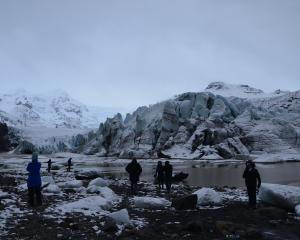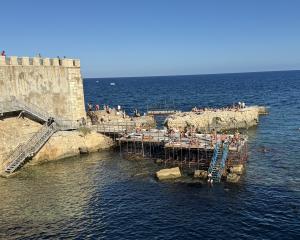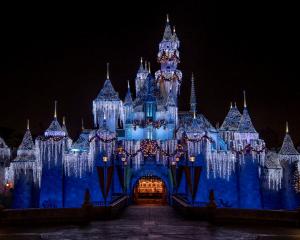
Were we mad? Many thought so when they heard our travel plans.
I tried to pack light, but failed.
As well as clothes, I had decided to home-school my three children while in Portugal, and had three bags of books.
"This is mad," my husband said, counting the bags before take-off.
He was right.
For the first time in our lives we had to pay for excess baggage.
But while the packing might have been out of control, our vision for life wasn't.
We knew exactly what we were doing.
Choosing to spend your life with someone from outside New Zealand is never straightforward.
As well as the emotional hurdles and sacrifices that come from one of you always living on the other side of the world away from family, you will always be broke.
At least, we are, and adding up how much we've spent on international travel just to visit family is a futile and depressing exercise.
However much money you would have had if you'd married a nice Kiwi boy, you will always have less if you pick someone from overseas.
Everything we earn goes towards paying for air tickets instead of mortgages and overdrafts, much to my bank manager's dismay, and we're past laughing when people tell us how wealthy we must be to travel so much.
"You are rich in other ways," our friend Vicki tells us when I'm looking glum about our finances.
I like to think that's true as I watch my children learning Portuguese and trying French while living in Europe, visiting fortresses and Roman ruins as part of daily life, and revelling in the love of family and friends who are not just my husband's, but theirs too, a culture not foreign but one that is their own.
I'm proud of the effort we've made to spend time in Portugal (which is as far away from New Zealand as you can get, and as much for an air ticket as you are ever likely to pay).
My children know and love their family there as they do their family here.
And when their grandfather died in Portugal two years ago they grieved as they would have had they lost a grandparent here.
This was good, because it meant my husband and I had succeeded - family in Portugal was as important to my children as family in New Zealand.
A tiny archipelago sits in the azure Atlantic Ocean, circled by swirling seagulls and steeped in history.
It's an island paradise that's smug reward for those who have travelled the distance to the far reaches of Europe, finding a country that eludes many a traveller because it can just seem too far away.
But Portugal is worth the effort; your euro goes further and many spots are well-kept secrets, a welcome world away from the touristy Algarve.
Anyone arriving at the Berlenga Islands, 10km off the coast of Peniche, will enter an outcrop of russet rock, fishermen's houses and calm, a place of natural beauty that deserves its worldwide acclaim.
Berlenga Grande is the largest of the cluster of three tiny islands and the only one of the group you can visit.
Full of twisting rock formations and spectacular caverns, its crowning glory is the Forte de Sao Joao Baptista, an imposing 17th century fort now housing hostel rooms against a dramatic backdrop.
Steadfast despite repeated attacks from foreign armies and pirates, today the fort is the centre of clear blue waters begging to be explored by boat or by diving deeper down.
A glass-bottomed boat is one of many tourist operators and fishermen use to take visitors around the many tunnels and caves, as well as the hauntingly beautiful Covo do Sonho (Dream Cove), framed by majestic red granite cliffs.
Scuba divers or snorkellers will find shipwrecks and sea life protected by Berlenga's official nature reserve status.
The island is rich in plant life and tiny geckos, and has thousands of nesting sea-birds, including guillemots and herring gulls, which swoop and squawk as you climb a winding track to the island's solid, picturesque lighthouse, built in 1841.
Centuries ago monks used to live on the island, but now it is home to just a handful of hardy fishermen, whose tiny homes overlook the jetty where boats arrive from Peniche.
A miniature beach is nestled at the foot of a small terraced area with camping sites.
If you're lucky enough to stay the night, listen out for the distinctive cry of nocturnal shag-like "pardelas", a signature tune of the island.
They interrupt the stillness to remind visitors the area belongs to them, and we are just passing through.
A limited number of rooms are also available at the one restaurant/pensao on the island, and snacks and Sagres (Portugal's best, light lager beer) sell like hot cakes at the welcoming "Castelinho", a little castle-like shop beneath the fishermen's huts.
On a clear summer's day, it's a mecca for hungry tourists as well as locals who often arrange their entire holidays around a summer break in Berlenga.
Watch out for fishermen and divers returning with a variety of fish, crabs and octopus.
Doused in olive oil and rock salt and grilled over charcoal, or simmered with piri-piri chilli and white wine, it's a feast that will whet your appetite for more amazing seafood on your return to Peniche.
Just 90km north of Lisbon, the pretty seaside town is full of fantastic restaurants, all specialising in freshly caught seafood; sea bass, squid and fresh sardines are char-grilled, often on open barbecue areas in full view of diners, and served on giant platters with potatoes and a fresh lettuce and tomato salad, bottles of olive oil sitting on the table.
So famous is Peniche for its specialty fish stew, "caldeirada", busloads of tourists arrive on Saturdays and Sundays just to eat the steaming pot of seafood, tomatoes, onions and garlic, similar to a French bouillabaisse and served for two people, although portions are so huge it will often feed three or four.
Sitting comfortably beside a basket of "peasant-style" bread and a fresh white or "green" wine (the slightly sparkling vinho verde), the mouth-watering meal is the ideal way to wind down after a hot day at one of Peniche's several world-class beaches, long stretches of white sand and clean water, offering fantastic surfing conditions, all proudly boasting the prestigious blue flag, the highest the European beach classification system awards.
Here cafés selling strong coffee perch right beside the sea, some glimpsing the strong stone wall that surrounded Peniche hundreds of years ago when it used to be an island, before silting formed a narrow piece of land to form its present peninsula.
Spectacular churches full of hand-painted blue and white "azulejos", or tiles, take pride of place throughout the fishing town, sitting alongside souvenir shops selling handmade boats and ceramics and exquisite bobbin lace, for which Peniche is famous.
A comfortable size to stroll around on foot, the town boasts the significant 16th-century "Fortaleza", once an important stronghold against foreign invasion and later used as a political prison, from 1934 to 1974, during the dictatorship of Antonio Salazar.
A museum inside the fort leads on to cells and a torture chamber used in the prison, but try not to let the grim history overshadow the magnificence of the fortress itself, burnt yellow walls and brickwork showing where cannons once lay, and arrows were fired.
It's a history with an interesting footnote: two Portuguese students heard toasting their country's freedom during the dictatorship and imprisoned in the Peniche fortress for their trouble, were the inspiration for Amnesty International, when English labour lawyer Peter Benenson heard of their sentence and launched a public "Appeal for Amnesty" in 1961.
Prisoners were released from the political prison after a peaceful military coup overthrew the dictatorship on April 25, 1974.
The Peniche fortress was also later used to house refugees from Portuguese African colonies made independent after the military coup. - Pam Jones











